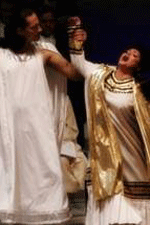> [Archived] Chronicles

Opening Season at the National Opera of Bucharest - Oedipus by Enescu
After the new Oedipus production was presented at the George Enescu Festival, The National Opera of Bucharest opened its season with the same work by Enescu, directed by Anda Tabacaru-Hogea, screenplay by Viorica Petrovici and choreography by Razvan Mazilu, with Tiberiu Soare at the music rack. The orchestra was unexpectedly fabulous, with an expressive and confident sound, the conductor proving his indisputable qualities once again, unanimously appreciated.
Debuts in the cast
The cast, aside from the well-known soloists from the previous stages, consisted of a few debuts - Liviu Indricau (a tenor who is said to be a "promise", gave a well-rounded performance in the Shepherd), Marius Bolos (scrupulous in his performance of The Great Priest, but did not stand out), Sidonia Nica (honest in Iocasta), Andra Rosu (a generous, interesting voice in The Sphinx). In the usual manner, we also listened to Stefan Ignat (Oedipus), Ionut Pascu (a last minute replacement for Eugen Secobeanu in Creon), Pompei Harasteanu (as always, in Forbas), Mihnea Lamatic (The Guardian), Vicentiu Taranu (Teseu), Crina Zancu (Antigona), Miruna Sturza (A Theban). The chorus was homogenous and dense (trained by Master Stelian Olariu); ballet dancers Bianca Stoicheciu and Virgil Ciocoiu performed their debut in the "golden couple" (I did not quite understand the meaning of the phrase), while (probably) the Erinyes were performed by a few young women with red hair and black cloaks, blowing in the wind even around Tirenias, a character with a pristine essence, in which I was glad to listen to bass George Crasnaru once again, on the stage of the Opera, after so many years, easily detaching himself by the intensity of his performance, by the tension of his sharp discourse, highlighting even the meaning of the word, which thus receives its arduousness.
A long line of directing blunders
The show left me speechless and I was even revolted at times, the directing blunders showering the stage. For example, (the same) Tiresias comes in with blood all over his face (as Oedipus was supposed to be after he had taken out his eyes), although he is a blind seer, so it is a lost metaphor, annulled by such an approach. Then, at the end of the scene, The Shepherd gives the newborn to Forbas, on the steps on the right of the stage, while on the left enters…Oedipus, already an adult in the next scene, which might confuse a rude observer. In the monologue, the hero clearly states that he is at a crossroads, but…this doesn't exist, but, in exchange, from a sort of hatch emerges a smoking oven (I later found that it was supposed to be Hecate!), behind which Oedipus kills Laius, a king who enters walking, although the Shepherd mentioned that you can hear the wheels of the royal wagon. The Sphinx emerges immediately, from the same hatch, in a long cloak - all coral-red (an obsessing color for the National Opera over the last years), with some sort of gloves covering his hands, that the legend says are supposed to be frightening wings.
In the coronation scene, the apotheosis of the moment is missed altogether, because, while the chorus (the people) sing "praise, praise", Iocasta lays on a pedestal and Oedipus leans over and kisses her…in the public square ! Maybe the gesture was supposed to be a representation of the incest, but…Not mentioning other less tragic scenes, in the final scene (in which the fountain is replaced by a glass bowl) even the intention of the composer is contradicted (accused of mysticism in the premiere of 1958, reason for which it was under ban back then) through which Oedipus purifies himself and is lost forever - but now, he climbs that (multifunctional) pedestal, Theseus hands him a golden crown (?!), and the hero remains still, like an eternal statue… Why?
In an almost permanently diffuse light, but with almost permanent projections, the show is somewhat on the classical line, evoking Hellas especially through the suggestive costumes, most of which were white, some resembling antique robes, with a unique décor consisting of a platform flanked by stairs, where most of the important scenes take place, but its placement toward the back of the stage made it difficult for the voices of the performers standing on the platform to be heard, in spite of the soloist' efforts. The luckier ones were those performing towards the front of the ramp.
A quiet performance, lacking magnitude and drama
Especially because I was a classic, I expected that the production would have been well received by critics and specialist (and I was right), but I was astounded by the fact that none of the critics noticed the blunder-details that are no longer the in the area of subjectivism or malevolence, but are striking even to those who have only read the legend. As a whole, the performance lacks magnitude and drama, so it…quiet, and the soloists rather uninvolved, but the fifth edition of Enescu's work on the stage of Bucharest will always be in the repertoire, which benefits the score whose fate has been rather hard over the last decades at the National Opera. Be that as it may, at the opening of the season, the hall was not full, it was actually rather empty.
Translated by Laura Bosnea and Elena Daniela Radu
MTTLC, University of Bucharest














